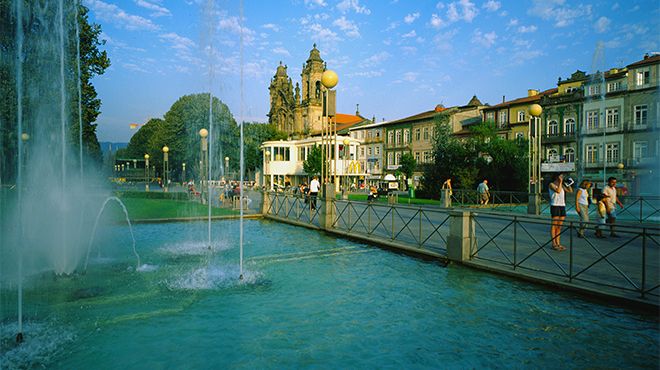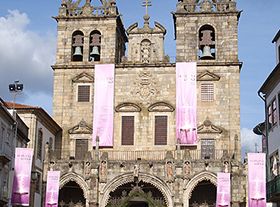Braga

Braga
Towns and Villages
Work on the Roman "Bracara Augusta", a regional juridical capital, began during the reign of emperor Augustus in 27 bc. It was part of the Empire´s network criss-crossing the Iberian peninsula to link it with Rome. Demonstrating the importance of the settlement, Emperor Caracala raised it to the status of capital of Galician province in 216. In the same century, the Diocese de Braga was established under the rule of Bishop Paterno.
With the decline of the Roman Empire, the city was first taken over by the Sueves, who made it their political and intellectual centre, before the Visigoths and Muslims moved in. It was mid-11th century before the city was reconquered by Christians and the archdiocese restored to Bishop Pedro. Throughout Muslim rule, the bishops had moved their place of residence to Lugo (Spain). In 1112, with archbishop Maurício Burbino, the religious history of Braga gained predominance. After a dispute with the Se in Compostela, in 1199, Pope Innocence III transferred jurisdiction over Oporto, Coimbra and Viseu, along with five other dioceses in what is now Spain, to Braga.
The Se in Braga is the oldest in Portugal and was the major religious reference point throughout centuries. Thus comes the popular saying "older than the Braga Se", to denote something that is extremely old. Always subject to the ecclesiastical influence that has naturally reflected on the city´s heritage, it is possible to conclude that the 16th and 18th centuries represent peaks in its history and development. First, there was the role of the Archbishop Diogo de Sousa, "the rebuilder of Braga". As from 1505 he took over civil and religious rule and set about transforming the "village into a city" (in his own words). Then came Archbishops Rodrigo de Moura Teles and José de Bragança who left behind the exuberant Baroque style.
Industrialisation and the founding of a university did much to contribute to the current development of the city that has held onto both secular and religious traditions. This is played out every year during events in Holy Week or the Festival of St. John the Baptist in June. These are wonderful opportunities to visit Braga, touring its Historic Centre or reliving the Pilgrimages to Santiago that would pass through here. Outside the city, there is the Way of the Marian Sanctuaries or the particular charm of the Cordophone Museum.
With the decline of the Roman Empire, the city was first taken over by the Sueves, who made it their political and intellectual centre, before the Visigoths and Muslims moved in. It was mid-11th century before the city was reconquered by Christians and the archdiocese restored to Bishop Pedro. Throughout Muslim rule, the bishops had moved their place of residence to Lugo (Spain). In 1112, with archbishop Maurício Burbino, the religious history of Braga gained predominance. After a dispute with the Se in Compostela, in 1199, Pope Innocence III transferred jurisdiction over Oporto, Coimbra and Viseu, along with five other dioceses in what is now Spain, to Braga.
The Se in Braga is the oldest in Portugal and was the major religious reference point throughout centuries. Thus comes the popular saying "older than the Braga Se", to denote something that is extremely old. Always subject to the ecclesiastical influence that has naturally reflected on the city´s heritage, it is possible to conclude that the 16th and 18th centuries represent peaks in its history and development. First, there was the role of the Archbishop Diogo de Sousa, "the rebuilder of Braga". As from 1505 he took over civil and religious rule and set about transforming the "village into a city" (in his own words). Then came Archbishops Rodrigo de Moura Teles and José de Bragança who left behind the exuberant Baroque style.
Industrialisation and the founding of a university did much to contribute to the current development of the city that has held onto both secular and religious traditions. This is played out every year during events in Holy Week or the Festival of St. John the Baptist in June. These are wonderful opportunities to visit Braga, touring its Historic Centre or reliving the Pilgrimages to Santiago that would pass through here. Outside the city, there is the Way of the Marian Sanctuaries or the particular charm of the Cordophone Museum.




 Explore
Explore 
 Remember and Share
Remember and Share 


